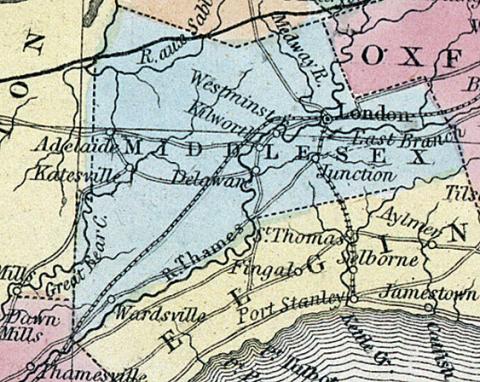LONDON. The District Town of the London District, situated in the township of London, on the River Thames, eighty-five miles from Hamilton, twenty-six from Port Stanley, and seventeen from St. Thomas. The town was laid out in 1826 by the Crown, on land reserved by Governor Simcoe; it returned a member in 1836, and was incorporated in 1840. It is finely situated, being in the midst of +beautiful country, and at the point of junction of the two branches of the River Thames.London possesses a handsome jail and court house, built of brick in the form. of a castle; the building of the two cost above £10,000. Large barracks, capable of accommodating a regiment, and Artillery barracks in addition, both of which are occupied. A fire company with one engine, a theatre, and two market buildings. Within the last two years London has been twice nearly destroyed by fire. The Episcopal Church was burnt down in February, 1844; a large subscription was raised to rebuild it, and London can now boast of possessing the handsomest gothic church in Canada West. It was designed by Mr. Thomas, Architect, of Toronto (late of Leamington, England). Its erection cost nearly #5000. A fire took place on the 8th October, 1844, when a large portion of the town was burnt; a second fire occurred on the 12th April, 1845, when about 150 buildings were consumed. Building, however, has been proceeded with rapidly; and in place of the old frame buildings, handsome streets have been erected, composed of brick buildings three and four stories high.
Excellent roads stretch away in every direction. A plank road has been formed to Port Stanley, and a plank and macadamized road to Brantford. New roads have also been completed to Chatham and Port Sarnia. Stages leave London daily for Hamilton, Chatham, and Detroit, and all intermediate places; three times a-week for Port Sarnia and Port Stanley; and twice a-week for Goderich.
A weekly newspaper, the “Times,” is published here.
Churches and chapels, 10; viz., Episcopal, two Presbyterian, Catholic, British Wesleyan, Canadian Wesleyan, Episcopal Methodist, Congregational, Baptist (for coloured people), and Universalist.
Post Office, post every day.
Population about 3500.
The following Government and District offices are kept in London:- Judge of District Court, Sheriff, Clerk of Peace, Treasurer, Crown Lands Agent, Judge of Surrogate Court, District Clerk, Clerk of District Court, Deputy Clerk of Crown. Professions and Trades.—Seven physicians and surgeons, seven lawyers, one grist mill, one saw do., twenty-six stores, four breweries, two distilleries, carding machine and cloth factory, eighteen taverns, three hardware stores, one carriage maker, one fanning-mill maker, one smut machine maker, two foundries, one printer, three machine shops, five notaries public, four druggists, two auctioneers, four tallow chandlers, one bookseller and stationer, three tanneries, twelve groceries, ten cabinet makers, five saddlers, fifteen tailors, two hatters, two livery stables, nine butchers, one builder, four tinsmiths, two chair makers, five waggon makers, fifteen blacksmiths, eight bakers, four coopers, one gunsmith, two nursery gardens, one dyer, one tobacconist, six painters and glaziers, three confectioners, one well-sinker, two stone cutters, three watchmakers, four barbers, seventeen shoemakers, one ladies' school. Four bank agencies—“Upper Canada,” “Montreal,” “Commercial,” and “Gore.” Principal Taverns.—The “Hope Hotel,” “Western Hotel,” and “London Coffee House.” Lee's and Scott's are also comfortable houses. A large hotel is now in course of erection. (Smith's Canadian Gazetteer, 1849)
Annotations
Latitude
42.983611
Longitude
-81.249722
Type
City or Town
County
Middlesex

